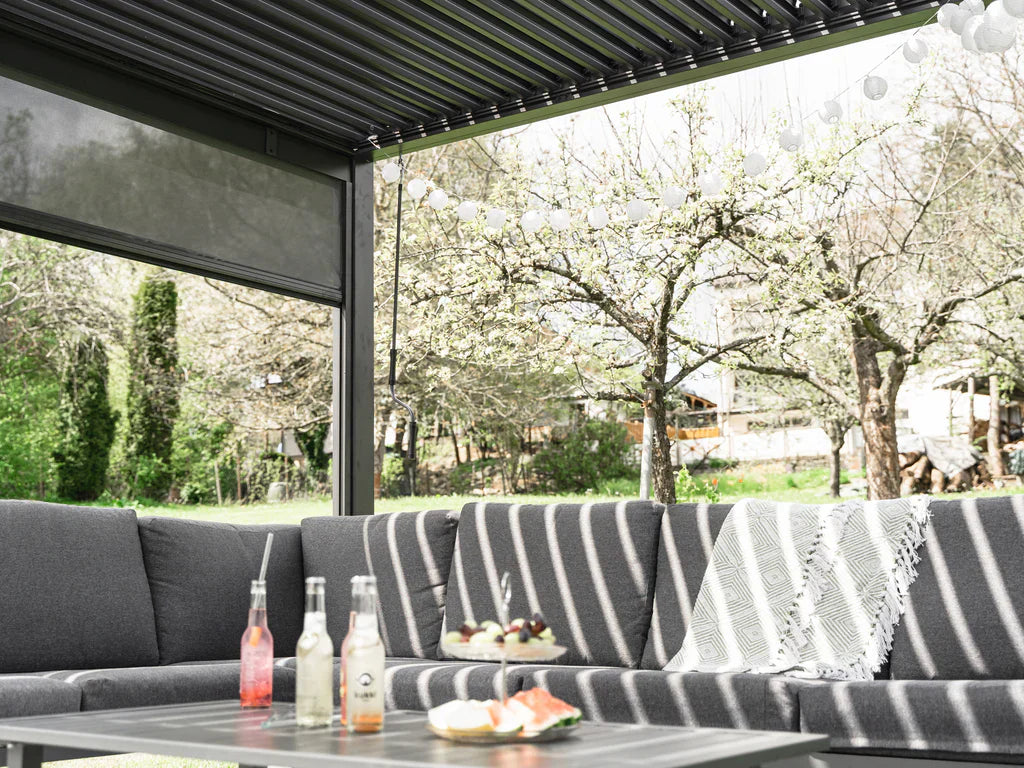Complete Guide to Creating a Backyard Shade Area

Luxury homeownership is about shaping a space around how you want to live.
Outdoor spaces are extensions of the home: places to relax, entertain, cook, and connect. Shade structures enhance and define the environment.
This guide is designed for those considering a backyard pergola or shade solution. We'll walk through design inspiration, material choices, customization options, installation considerations, and long-term maintenance.
In this guide:
- Types of backyard shade options
- Backyard retractable shade
- Comparison table of shade options
- About attached vs. freestanding shade
- Picking the right material
- When to choose a pergola
- Buying versus building (DIY considerations)
-
When you need a permit
- Ideas and designs
- Options for small backyards
-
Accessories and add-ons
- Explore kits and ready-to-build options
Types of backyard shade features
Outdoor shade structures come in many forms, each with its own strengths:
- Pergolas frame an outdoor room with open slats overhead, giving you shade while keeping the sky in view.
- Gazebos provide an enclosed retreat, ideal for year-round gatherings protected from sun and rain.
- Awnings extend directly from the house, fixed or retractable, for quick shade on patios and decks.
- Shade sails stretch fabric into sculptural shapes, creating a contemporary look with flexible coverage.
- Arbors act as inviting entryways or cozy plant-covered nooks, often marking transitions in the garden.
- Lattices are the simplest option, adding vertical texture and a place for climbing plants to thrive.
Each option enhances outdoor living in different ways. The right choice depending on how you want to use your space.
Backyard retractable shade options

Most people think of a retractable awning, but other structures can provide adjustable shade. Some shade sails allow you to slide them open or closed.
A pergola with louvered roof panels can be adjusted by hand, a crank, or sometimes with a remote controlled motor. Modern pergola kits often offer smart home integration, which allows you to have the roof open or close on a schedule.
Picking a shade structure for your space
Start by marking where shade is needed most at different times of day. Then, match the structure that provides the right balance of coverage, style, and permanence for that spot.
| Consideration | Pergola | Gazebo | Awning | Shade Sail |
|---|---|---|---|---|
| Level of Shade | Flexible, can adjust with louvers or screens | Full roof coverage | Full shade when extended | Partial to full, depending on fabric and angle |
| Cost Range | $$--$$$$ | $$$--$$$$ | $--$$$ | $--$$ |
| Popular For | Creating defined living/dining zones | Shelter or a garden centerpiece | Quick shade for patios/decks | Affordable, modern coverage in open spaces |
| Flexibility | High, works in many sizes, styles, and materials | Moderate, size/style are more fixed | Limited to patio/deck coverage | Very flexible placement and size |
| Design Impact | Defines outdoor "rooms"; adds vertical interest | Creates a strong focal point; enclosed feel | Subtle, blends into home | Modern, sculptural, lightweight |
| Connection to Home | Can be attached or freestanding | Usually freestanding | Always attached | Freestanding (can attach to posts, walls, or both) |
| Maintenance | Varies by material (wood, vinyl, metal, fiberglass) | Similar to pergolas; more roof upkeep | Minimal (clean fabric/hardware) | Minimal (clean and re-tension fabric) |
Attached vs. freestanding shade structures (pros & cons)
Whether to anchor your structure to the home or let it stand alone depends on where and how you want to create your space.
Attached backyard shade structures

Attached pergolas, awnings, or shade roofs connect directly to your home's exterior wall. They often extend from over a patio door or deck. It creates a natural extension of your living space and a smooth transition between indoors and out.
When attached is best:
-
- You want to blur the line between inside and outside, creating a space that extends off the main home.
- Space is limited, and attaching the structure maximizes usable area without extra posts or supports.
- You want a structure that blends into your home's architecture or footprint.
- You're planning to cover an existing patio or deck directly adjacent to the home.
Considerations for attached:
-
- Requires a structurally sound wall for anchoring.
- Installation may be more complex, sometimes involving permits.
- The final design is tied closely to your home's style and footprint.
Freestanding backyard shade structures

If you want a getaway within your own backyard, freestanding is the way to go. Freestanding pergolas, gazebos, or shade sails can be placed anywhere in the yard. They're ideal for creating destination spaces like a shaded lounge by the pool, a garden retreat, or a focal point in open landscaping.
When freestanding is best:
-
- You want to define a new outdoor "zone" separate from the house.
- Your yard is large enough and open, offering design flexibility.
- You want a focal point, poolside lounge, or outdoor dining pavilion.
- You may want to relocate or expand the structure in the future.
Considerations for freestanding:
-
- Requires proper footings, framing, or anchoring for stability.
- May need additional elements, like pathways or landscaping, to feel visually connected to the home.
- Can be more exposed to weather and sun, depending on placement.
Choosing the right material for a backyard shade feature
The material you choose shapes the look and the lifespan of your pergola. Here's what to consider when deciding the best option for your backyard:
Fabric
Fabric is the primary material for shade sales or awnings. High-density outdoor fabric comes in many colors, shapes, and sizes. Fabric shades provide less durability than rigid structures. They need proper tensioning. Some may require seasonal removal in areas with heavy snow or wind.Homeowners looking for quick, stylish shade solutions with minimal cost or permanence. You will need to wipe them occasionally with mild soap and water and adjust tension as needed to prevent sagging.
Wood
cedar, redwood, pressure-treated pine
Wood pergolas appeal to those who want traditional charm and don't mind regular upkeep to preserve it. Warm, natural character that can be stained or painted to match your style. Each piece is unique. Wooden shade structures need ongoing care. Resealing or staining every 1-3 years prevents rot, warping, or insect damage.
Vinyl
A low-maintenance alternative, requiring only an occasional rinse with a hose or mild detergent to remove dust or mildew. Resistant to rot, insects, and fading. Easy to clean with soap and water. Vinyl pergolas often come in fewer color options. The uniform surface can look less natural. Vinyl suits homeowners who want a clean look with little maintenance, even if it means sacrificing some texture.
Metal
aluminum, steel
The sleek and modern option. Strong, durable, and more resistant to weather. Aluminum stays rust-free while being lightweight. Steel is heavier but offers extra strength. Both create a contemporary aesthetic. Metal pergolas are ideal for modern designs and harsh climates where durability and longevity matter.
Fiberglass
A higher-end option with the highest upfront cost. Extremely durable and lightweight. Can be longer in length or depth without extra support. Virtually maintenance-free. Fiberglass is the choice for those seeking premium performance and sleek design, with little concern for budget.
When to choose a pergola for backyard shade
A pergola is best for those seeking flexible outdoor enjoyment all year. They are not just a summer investment. Modern pergola kits make it easy and more affordable to create a four-season living space. Homeowners use them to transform a backyard into a regular outdoor living space by creating a defined space for dining or lounging.
A pergola creates shade while letting in light and air. Unlike a gazebo, which has a fixed roof, modern pergola designs offer adjustable roof panels (known as louvers) that can be closed for weather protection.
| Season | Pergola Benefits | Relevant Features & Accessories | Pro Tips |
|---|---|---|---|
| Spring | Adjustable roof panels and retractable shades let you manage sun exposure as temperatures fluctuate. The structure is a natural frame for climbing plants and spring blooms. | Adjustable louvers, retractable shade walls, integrated drainage systems, plant trellises | Choose a model with built-in drainage to handle frequent spring showers. |
| Summer | Provides a cooler, shaded refuge from intense sunlight while maintaining airflow. Expands your usable space for outdoor dining, grilling, or family activities. | Retractable side shades, UV-resistant canopy panels, vented louvers for airflow | Retractable shades on west-facing sides can make evening gatherings more comfortable by protecting against low-angle sun glare. |
| Fall | Extends outdoor living into cooler months. Modern designs with adjustable roofs keep autumn leaves from piling on outdoor furniture. Creates a cozy space for seasonal dining, fire pits, or outdoor gatherings. | Wind-blocking screens, attachable heaters, insulated side panels | Consider side panels or privacy screens to shield against gusts. Infrared or electric heaters can keep the space warm well into the season. |
| Winter | Provides a sheltered outdoor space that can be enjoyed year-round with the right accessories. Modular walls and heaters let you enjoy snow from in your personal glass observatory. | Glass enclosure panels, infrared heaters, integrated LED lighting | Opt for models with adjustable roof panels and walls to seal out snow and cold. Integrated lighting keeps the space functional once the sun starts setting earlier. |
How to build a backyard pergola
There are different ways to bring your structure to life. Some homeowners enjoy the challenge of building their own. Others prefer the efficiency of hiring professionals. The right choice depends on your skills, budget, and goals.
| Build Option | Pros | Cons | What You Need | Best For |
|---|---|---|---|---|
| DIY (From Scratch) | No labor cost, fully customizable if you have the skills | Time-intensive, requires tools, higher risk of mistakes | Raw materials, plans (often self-sourced) | Experienced builders who want full control and savings |
| Kit | Pre-cut, pre-drilled parts; easier assembly; cost-effective | Still requires time and effort; limited customization | Structural materials, hardware, instructions (tools not always included) | Homeowners with moderate DIY skills looking for a weekend project |
| Professional Installation | Expertise, faster completion, often includes warranty | Higher cost due to labor | Consultation, design support, sourcing, build, cleanup | Homeowners who want a stress-free, polished result |
| Custom Build (Contractor) | Fully tailored design, widest choice of materials | Highest cost | Design and construction handled start to finish | Homeowners seeking a unique, long-term investment |
Backyard pergola ideas, design & inspiration
A pergola is a statement piece. It becomes a design feature that brings depth, character, and comfort. You want the size and style to complement your house and garden.
The design choices should fit how you'll use the space; an all-season outdoor dining room with garden views will be quite different than a cozy shaded reading nook.

Modern & Minimalist. Sleek lines and dark color helps the pergola fade out of view into shadows and evening skies. Sliding glass walls keep buys and cold air out while minimizing obstructions to your backyard view. Choose furniture with clean lines, neutral colors, and metal or concrete accents.

Bright & Classic. Light finishes, white-washed woods, breezy outdoor curtains, and cushions in shades of blue and sandy beige. Popular for poolside or those seeking a coastal feel. White frame structures also brighten darker areas.
 Mediterranean-Inspired. A fire feature is the centerpiece, giving warmth on cool evenings and a natural gathering spot for conversation. Climbing vines and handing foliage give this space a lush, timeless atmosphere. Chunky wooden furniture and warm, earthy tones in cushions and rugs add to the cozy allure.
Mediterranean-Inspired. A fire feature is the centerpiece, giving warmth on cool evenings and a natural gathering spot for conversation. Climbing vines and handing foliage give this space a lush, timeless atmosphere. Chunky wooden furniture and warm, earthy tones in cushions and rugs add to the cozy allure.
Pergola ideas for small backyards
 Pergola kits start as small as 10'x10' or custom builds can fit areas even smaller. Some tips for smaller backyard areas:
Pergola kits start as small as 10'x10' or custom builds can fit areas even smaller. Some tips for smaller backyard areas:
- Go for multifunctional furniture. Look for stools that can be pushed into one another, tables that fold out, to keep the space open when desired.
- Use mirrors, glass, and reflective elements to help the space appear more open.
- Add an outdoor rug to make the space feel intentional and cozy.
- Maximize vertical space. Use hanging plants and plant stands, or plant climbing plants to create additional green space.
- Match materials to your indoor space, helping make the area feel like an extension of a larger part of the home.
- Add glass walls. This turns a small deck or patio into a four-season sunroom, extending the living space for better gardens views without bugs or rain.
Accessorizing your shade space
Once your pergola or shade structure is in place, accessories bring it to life. From climate control to privacy and ambience, you can turn an outdoor frame into a fully functional living space.
| Accessory | Benefits | Installation |
|---|---|---|
| Lighting | Extends outdoor use after dark; improves visibility and safety; adds ambience. | Consider a pergola kit with integrated LEDs for remote control and color-changing options built into the design. String lights and solar or low-voltage systems work well for retrofits. |
| Heaters | Extends comfort into cooler months; enables year-round outdoor use. | Electric infrared heaters can come ready to install or be mounted to pergola beams; follow clearance and safety guidelines. |
| Privacy Screens | Blocks wind and glare; adds shade and enclosure; increases comfort and privacy. | Retractable fabric screens or fixed slats can often be added during or post-installation. |
| Glass Walls & Sliding Panels | Creates an enclosed, weather-protected space while maintaining visibility and natural light. | Many brands offer glass wall panels that integrate with modular pergola systems on sliding tracks. |
| Climbing Plants & Greenery | Adds natural shade, color, and cooling; integrates the structure with the landscape. | Train vines along posts or trellises; avoid invasive species near foundations. Strategically placed pots and planters can soften the edges of the space. |
| Furniture | Creates another living space to relax, gather, or dine. | Look for furniture made from materials designed for outdoor use. This ensures your furniture resists rust, rot, and fading. |
| Fireplace or Fire Pit | Allows warmth in cooler months, can be used for cooking. | Maintain a safe distance from furniture, cushions, and the pergola structure itself to prevent damage from heat or flying sparks. |
Do you need a permit for a pergola, gazebo, or shade feature?
Rules around adding structures to your property vary by city and county. The need for a permit depends on the size, placement, and permanence of your structure.
Check with the building or public works departments for your specific city and county. Each may have different rules. Many cities allow you to dial 311 to be connected with the correct government department.
- Pergolas and Arbors – Smaller, open-roof designs sometimes will not require a permit if under a certain height or square footage. If you're adding a larger roofed structure, or it will be attached to a home, check with the building or public works departments.
- Gazebos and Pavilions – Because they have solid roofs and permanent footings, these typically require a building permit and sometimes zoning approval for setbacks.
- Awnings – Retractable awnings often fall under "temporary" structures, but fixed versions that alter your roofline may need review.
- Shade Sails – Rules depend on how they're anchored. Freestanding posts being added to hold the sail may need approval, while wall-mounted sails sometimes don't.
Key factors you'll need to know, which influence permit requirements:
- Size and height of the structure
- Whether it's attached to a house or freestanding
- Foundation type or footing depth
- Proximity to property lines or utilities
- Local wind and snow load standards
Learn more about pergola foundations and their potential permit needs.
Explore backyard pergola models
At PERGOLUX, simplicity meets durability. Our pergola kits are quick to assemble, low-maintenance, and designed for maximum stability. Built from high-quality aluminum, they can handle rain and snow with ease while staying rust-free and looking beautiful for years.
Add wind and privacy screens, wooden slat walls, LED lighting strips, or even outdoor heaters to keep things cozy year-round. We provide pergolas and accessories designed to work perfectly together.
Ready to elevate your backyard with the perfect pergola? At PERGOLUX, we're experts in pergolas and accessories. Begin your design journey by phone, chat, or even video consultation. Contact us today to get all the information you need about transforming your backyard.
This guide was reviewed and updated in October 2025.


